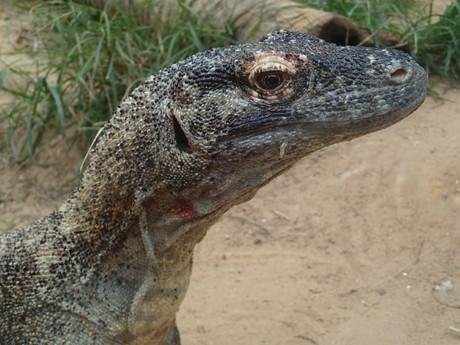Fighting superbugs with dragon blood

US scientists have been investigating the survival mechanisms of Komodo dragons, which live on five small islands in Indonesia. The creatures thrive in this environment, despite being exposed to scads of bacteria that would kill less hardy creatures — in fact, the dragons’ own saliva contains at least 57 species of bacteria, which are believed to contribute to the demise of their prey.
Substances known as cationic antimicrobial peptides (CAMPs) are produced by nearly all living creatures and are an essential part of the innate immune system. This immune system is particularly robust in Komodo dragons, with serum taken from the animals found to contain antibacterial activity. Researchers at George Mason University wondered whether they could isolate CAMPs from Komodo dragon blood, as they previously had done with alligator blood, to expand the library of known CAMPs for therapeutic studies.
Using an approach known as bioprospecting, the team incubated Komodo dragon blood with negatively charged hydrogel particles that they developed to capture the peptides, which are positively charged. With this method, they identified and sequenced 48 potential CAMPs with mass spectrometry. All but one of these was derived from histone proteins, which are known to have antimicrobial activities. Eight were synthesised and tested against Pseudomonas aeruginosa and Staphylococcus aureus.
Writing in the Journal of Proteome Research, the study authors revealed that seven of the peptides showed significant potency against both bacteria tested (the eighth was only effective against P. aeruginosa). The scientists thus concluded that Komodo dragon blood plasma contains a host of potentially viable antimicrobial peptides that could help lead to new therapeutics.
The research is especially timely, coinciding with the World Health Organization’s (WHO) recent announcement of 12 antibiotic-resistant ‘priority pathogens’ — families of bacteria that pose the greatest threat to human health. The WHO priority pathogens list for R&D of new antibiotics is as follows:
Priority 1: Critical
- Acinetobacter baumannii, carbapenem-resistant
- Pseudomonas aeruginosa, carbapenem-resistant
- Enterobacteriaceae, carbapenem-resistant, ESBL-producing
Priority 2: High
- Enterococcus faecium, vancomycin-resistant
- Staphylococcus aureus, methicillin-resistant, vancomycin-intermediate and resistant
- Helicobacter pylori, clarithromycin-resistant
- Campylobacter spp., fluoroquinolone-resistant
- Salmonellae, fluoroquinolone-resistant
- Neisseria gonorrhoeae, cephalosporin-resistant, fluoroquinolone-resistant
Priority 3: Medium
- Streptococcus pneumoniae, penicillin-non-susceptible
- Haemophilus influenzae, ampicillin-resistant
- Shigella spp., fluoroquinolone-resistant
Bacteriophage cocktail to combat superbugs
Entelli-02 is a five-phage cocktail designed specifically to target Enterobacter cloacae...
Exclusive colostrum intake may reduce risk of food allergies
Newborns who are exclusively fed colostrum in the first 72 hours following birth are five times...
Sunscreen and supplements can lower your vitamin D levels
People who use SPF50+ sunscreen daily are more likely to be vitamin D deficient, while taking...







